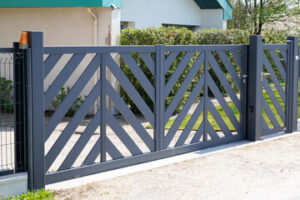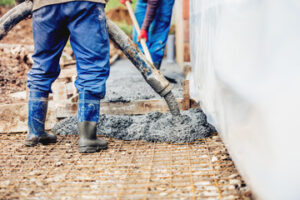Custom gates can enhance your property’s aesthetic and add security to your home or business. They’re available in a variety of materials, such as wrought iron or steel.

Choosing the right material depends on your preferences and requirements. To make an informed decision, consider these factors: security needs, durability, and maintenance. Keep reading the article below to learn more about Custom Steel Gates.
The materials used to build gates have a significant impact on their durability and longevity. This is especially true for residential & commercial gates, which must endure frequent use and harsh environmental conditions. Proper maintenance and expert installation can help ensure that these structures serve their intended function for years to come.
Wrought iron and steel are both excellent choices for gate fabrication, exhibiting a range of desirable properties that make them ideal for a variety of architectural styles. Both are incredibly strong, making them more resistant to damage and less likely to bend or break compared to other materials. Additionally, they can be easily customized to fit your specific aesthetic preferences.
A custom gate can be fabricated to fit any property’s architecture, providing a visually appealing first impression that enhances curb appeal and increases kerb value. The strength and security provided by metal gates also prevent unauthorized entry, safeguarding the safety of your home or business.
In addition to their durability and security, gates made from metals like wrought iron and steel are highly customizable. You can choose from a wide range of designs and finishes, ensuring that your gate perfectly complements your unique style and architecture.
If you’re interested in adding a modern twist to your gate, try selecting an aluminum option. This material is lighter than iron, making it easier to handle and install. In addition, it’s also resistant to corrosion and requires minimal maintenance — just occasional cleaning to keep it looking new.
When it comes to choosing a material for your gate, consider your needs and budget. Wrought iron gates are a classic choice, but they can be expensive. However, they are incredibly durable and can last for decades when properly maintained. Aluminum gates offer a more affordable option, while still offering superior durability and corrosion resistance. In the end, it’s important to select a material that best suits your needs and can meet your long-term goals.
Aesthetics
A custom gate is an opportunity to create a piece of art that blends robust security with elegant style. From ornate scrollwork to minimalist lines, the variety of options is endless. Whether crafted of wood or metal, these gates provide a sturdy barrier that enhances property security and adds visual appeal. Incorporating metal components into wooden gates, for example, creates a modern and contemporary appearance.
While many homeowners may opt for the traditional look of wrought iron, other materials like aluminum offer just as much versatility in terms of design. These gates can also be made with bronze, which develops a natural patina over time. It’s a beautiful addition to any garden, pool area or balcony.
The aesthetics of a custom steel gate can be further enhanced with the inclusion of automated opening systems and integrated smart technology. A combination of functionality and sophistication, these gates allow homeowners to showcase their discerning taste while leaving a lasting impression on visitors and passersby.
Custom gates can be painted in a wide range of colors, from traditional black to a hue that best compliments the home or property’s architecture. Choosing a high-quality oil-based metal paint helps prevent corrosion and rust while offering superior adhesion, as well as protecting the surface from moisture, pollutants and dust. A gloss sheen is preferred, as it combats the elements better and resists fading from sunlight.
Those seeking a more unique aesthetic can also incorporate custom motifs, incorporating floral patterns or even the company’s logo into the design of their gate. Personalized touches add to the elegance and craftsmanship of a gate, transforming it into a statement piece.
Choosing a qualified contractor is essential for maintaining the integrity and visual appeal of a metal gate over time. Look for contractors with a strong track record of customer satisfaction, as well as an extensive portfolio of past projects. Make sure the contractors you choose are licensed, insured and adhere to safety and quality standards. Regular inspections are also key to identifying minor issues early, allowing them to be resolved quickly and affordably before they become larger problems.
Security
When choosing a gate design, it is important to consider security as well as aesthetics. The gate should look beautiful and complement the overall design of the property, but it also needs to be strong enough to deter unauthorized entry and other unwanted activities. Using a high-quality material like stainless steel provides strength and durability while remaining aesthetically appealing. It is also resistant to rust and corrosion, making it the ideal choice for coastal areas where exposure to saltwater can damage other types of metals.
The security of a gate is crucial, especially for homes with children or pets. Gates are an effective deterrent for potential burglars and vandals, and they can be fitted with additional features to enhance their protective capabilities. These include tamper-proof designs, impact resistance, and alarm systems to deter intrusions and alert you of any unauthorized activity.
Custom gates are built to meet a wide variety of requirements and preferences. The fabrication process starts with a detailed consultation where clients outline their project goals and aesthetic preferences. Skilled artisans or fabricators then translate these concepts into precise designs, incorporating factors like material selection, dimensions, and decorative elements. The fabrication process uses a range of techniques like welding, cutting, and bending to craft the gate components. Finally, the completed gate undergoes finishing touches like painting or powder coating for aesthetic and durability purposes.
When installing a gate, it is important to choose the right type of mounting hardware and foundation. Ensure that the posts are correctly positioned and that they are securely anchored in place before pouring concrete to hold them in place. This process is crucial to the durability and safety of your gate, so make sure that it is done by a professional with experience in gate installation.
Another key step is to install a gate opener to allow for convenient access and automation. Look for options that offer remote controls, keypads, or smart home integration to simplify operation and improve convenience and security. In addition, it is vital to regularly clean and lubricate moving parts like hinges and tracks to reduce wear and tear.
Maintenance
The maintenance of custom iron gates requires routine inspection and cleaning to ensure the gate remains in good working condition. Keeping the gate clean can prevent dirt, debris, and rust from building up, which is important for both aesthetics and functionality. Additionally, ensuring the gate’s moving parts are properly lubricated can lower the risk of premature wear and tear.
Choosing a material that can withstand the weather conditions where the gate is located will also help reduce wear and tear. Powder-coating is a popular option, as it is durable and resists rust well. For a more dramatic touch, some homeowners may choose to paint their gates or add a custom design. Adding automation and security features like keypads, intercoms, or smart home integrations is another way to improve the functionality of a gate.
Some types of metals are more resistant to corrosion than others, and selecting the right metal is critical for reducing the amount of maintenance required. Wrought iron offers a classic look with high durability, while stainless steel provides a modern style with excellent resistance to rust and corrosion. Other durable metals include copper and aluminum, both of which are available in a wide range of finishes to match the style of your home.
Maintaining the structure of the gate is another important consideration, as damaged parts can compromise its safety and security. Regular inspections and maintenance can identify potential issues and allow them to be repaired before they become serious problems. Some repair tasks, such as replacing broken electrical components, require a professional, but other repairs can be completed by the homeowner.
Before starting any welding repair work on a metal gate, the first step is to prepare the area by cleaning it thoroughly and removing any rust or other debris that could be trapped under the weld. Next, the welder should select a patch that matches the gate’s material and cut it to size. Finally, the patch is welded to the hole using the appropriate welding technique for that type of metal. Once the weld is complete, the area should be cleaned again and touched up with a paint that matches the gate’s color.



